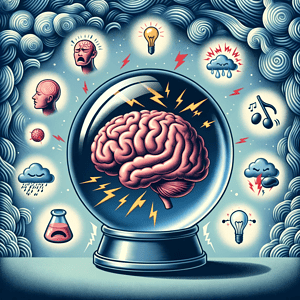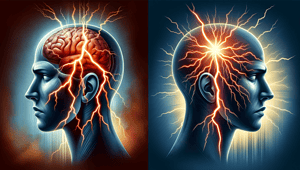Introduction
Defining Migraine: More Than a Headache
Think of a migraine as a thunderstorm in your brain, complete with flashes of lightning and booming thunder. Far from your typical headache, a migraine is a debilitating neurological condition that strikes like a vengeful maestro, orchestrating a range of symptoms from intense head pain to nausea.

Why Spotting Symptoms is Crucial
Recognizing a migraine’s early symptoms could be the first step toward reclaiming your life. Knowing what to look for helps you seek timely treatment, potentially mitigating the severity of the attack.
- Quick Recap
- Migraines are severe neurological conditions.
- Early detection can lead to effective management.
Ten Symptoms and Their Critical Importance
1. Throbbing Head Pain
This symptom is the hallmark of migraines, and it’s usually what sends people seeking medical advice. Ignoring it or writing it off as just another headache can mean enduring unnecessary suffering and potentially worsening your condition over time.
Why It’s Important:
Unattended, this pain can become chronic, making you more susceptible to future episodes. It also affects your ability to focus and lowers the quality of life.
2. Nausea
More than an inconvenience, nausea can make it impossible to ingest food or medication, potentially lengthening the duration of a migraine episode.
Why It’s Important:
Failure to manage nausea can lead to dehydration and malnourishment, further complicating your condition.
3. Vomiting
Often accompanying nausea, vomiting is a forceful ejection of stomach contents and could lead to dehydration.
Why It’s Important:
Vomiting often amplifies the vicious cycle of pain and nausea, making treatment more complex and potentially leading to weight loss and nutritional deficiencies.
4. Sensitivity to Light
Also known as photophobia, this symptom often forces people to retreat into dark rooms.
Why It’s Important:
The inability to tolerate light can significantly impair your daily functions, including the ability to work or drive safely.
5. Sensitivity to Sound
In medical jargon, this is called phonophobia. Like sensitivity to light, this can make daily tasks unbearable.
Why It’s Important:
This symptom can severely restrict your ability to participate in everyday activities and social engagements, adding an emotional toll to the physical symptoms.
6. Visual Disturbances
Flashing lights, zigzag lines, and blind spots can be disorienting and frightening.
Why It’s Important:
These symptoms can be dangerous if they occur while you’re performing tasks that require visual focus, like driving or operating machinery.
7. Muscle Weakness
You might feel like you’ve been sapped of strength, making even simple activities difficult.
Why It’s Important:
Muscle weakness can impair your mobility, which could result in injury if not managed properly.
8. Mood Changes
Sudden swings in mood can be disruptive and can often be mistaken for mental health issues.
Why It’s Important:
Ignoring mood changes can lead to misdiagnosis and inappropriate treatment, further aggravating your condition.
9. Neck Stiffness
A tight, uncomfortable neck can be debilitating and limit your range of motion.
Why It’s Important:
This can compromise your posture, leading to other health complications like spinal issues.
10. Frequent Yawning
An unusual symptom that often precedes other symptoms.
Why It’s Important:
Ignoring this early warning sign means missing the chance for early intervention, which could lessen the severity of the attack.
Migraine Phases: Understanding the Lifecycle
Prodrome Phase
Often called the pre-headache phase, prodrome symptoms like mood changes and frequent yawning can appear hours or even days before the migraine strikes. Take note and act accordingly.
Aura Phase
A fascinating yet distressing phase, the aura phase features symptoms like visual disturbances and muscle weakness, serving as an eerie prelude to the migraine headache.
Headache Phase
The main act of this neurological drama is the headache phase. The symptoms here are severe and can be incapacitating, including all the symptoms previously listed.
Triggers and Causes
The Root Causes
While the exact cause remains a subject of research, abnormal brain activity is often implicated in migraines. Your brain’s reaction to certain stimuli might be the spark that lights the migraine fire.
Triggers: The Spark to the Flame
From weather changes to strong odors, triggers are the external elements that might induce a migraine. These can be highly personal and identifying yours can be a critical step in prevention.
What Causes Migraines?
The Brain and Beyond
Migraines still stump the medical community. Abnormal brain activity is a likely culprit, but the full story isn’t told yet. Researchers are consistently probing the depths, but for now, we have more questions than answers.
The Trigger List
| Potential Triggers | Impact |
|---|---|
| Weather Changes | Unsettles the system |
| Skipped Meals | Crashes your energy |
| Strong Odors | Overwhelms your senses |
| Stress | Elevates your risk |
| Lack of Sleep | Wears you down |
Triggers can be as diverse as they are numerous. What pushes one person over the migraine edge might not affect another. Identifying your triggers could be half the battle won.
Diagnosis and Treatment: The Road to Relief
The Diagnostic Process
To diagnose a migraine, doctors usually perform a physical and neurological exam. They might delve into your family’s migraine history to better understand your condition. This is a comprehensive assessment designed to rule out other possible causes.
Treatment Pathways
- Medications: These range from over-the-counter analgesics to specialized prescription meds designed for migraines.
- Lifestyle Tweaks: Your lifestyle choices, including your diet, can make a difference. For instance, consider exploring a specialized migraine diet.
- Alternative Therapies: Acupuncture, biofeedback, and even certain herbs have been cited as useful in treating migraines.
Conclusion: Take Control, Don’t Be Controlled
Importance of Medical Attention
Ignoring migraine symptoms can lead to debilitating consequences. Timely medical attention can provide not just relief, but perhaps a roadmap for prevention and management.
Empowering You to Manage Migraines
Don’t underestimate the power of awareness. By understanding the symptoms, phases, triggers, and treatment options, you can transition from being at the mercy of your migraines to managing them effectively.
So, take the next step; schedule that doctor’s visit, identify your triggers, and consider making lifestyle changes that better equip you to battle migraines.
For more in-depth resources and personalized treatment options, don’t hesitate to visit Migraine Centers.
Knowing is half the battle; the other half is action. Reclaim your life; don’t let migraines rule it.




